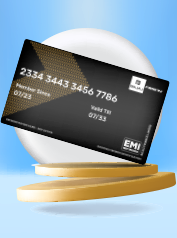
Fixed deposits remain one of the most trusted investment options for individuals looking for stability and guaranteed returns. When you buy a fixed deposit, the bank issues a Fixed Deposit Receipt as official proof of your investment. Knowing what a Fixed Deposit Receipt is and understanding its key components are essential for safeguarding your money.
An FDR is more than just a piece of paper; it plays a vital role when managing renewals, withdrawals, or applying for loans. Paying close attention to the format for a Fixed Deposit Receipt ensures your investment journey remains secure and hassle-free.
A Fixed Deposit Receipt (FDR) is a formal document provided by a bank or financial institution upon investing in a fixed deposit. It acts as a physical record of your investment, capturing key details like the deposit amount, interest rate, tenure, and maturity date. Essentially, the FDR functions as a contract, ensuring transparency and safeguarding the terms agreed between you and the bank.
Understanding the components of your Fixed Deposit Receipt is essential for effective investment management. Here's what a typical FDR includes:
Component |
Description |
|---|---|
Depositor's Details |
Full name, age, and address as per the identification documents provided. |
Deposit Amount |
The principal sum you have invested in the fixed deposit. |
Interest Rate |
The annual rate at which your deposit will earn interest. |
Tenure |
The duration for which the deposit is held, ranging from a few months to several years. |
Maturity Date |
The date on which your fixed deposit will mature, and you can claim the principal along with the accrued interest. |
Maturity Amount |
The total amount you will receive upon maturity, including both principal and interest. |
Deposit Type |
Indicates whether the FD is cumulative (interest paid at maturity) or non-cumulative (interest paid periodically). |
Nominee Details |
Information about the person nominated to receive the deposit in case of the depositor’s demise. |
Auto-Renewal Instructions |
Details on whether the FD will automatically renew upon maturity. |
Premature Withdrawal Terms |
Conditions and penalties associated with withdrawing the deposit before maturity. |
Bank Details |
Information about the issuing bank, including branch and contact details. |
Keeping your Fixed Deposit Receipt (FDR) safe is essential for protecting your financial security and ensuring smooth access to your investment whenever needed. Here’s why safeguarding your Fixed Deposit Receipt is so important:
Proof of Investment
A Fixed Deposit Receipt acts as legal proof of your investment and is required for any claims, renewals, or maturity withdrawals.
Facilitates Renewals and Withdrawals
Banks often request the original Fixed Deposit Receipt when you need to renew or withdraw your fixed deposit, making it crucial for timely transactions.
Loan Applications
An FDR can be pledged as collateral for loans, helping you access funds easily without breaking your second-hand investment or applying for unsecured credit.
Taxation Purposes
The Fixed Deposit Receipt contains important details such as interest earned, which you must declare correctly when filing taxes or claiming exemptions.
Ensures Smooth Handling of Financial Matters
By keeping your FDR safe and maintaining a digital copy, you protect yourself from unnecessary delays, disputes, or documentation issues related to your fixed deposit.
Understanding how and when your Fixed Deposit Receipt (FDR) is required can save you from delays and complications during important financial actions. Here are the common scenarios where your Fixed Deposit Receipt becomes essential:
Renewal of Fixed Deposit
When you renew your fixed deposit at maturity, the bank will ask for the original Fixed Deposit Receipt to process the renewal smoothly.
Premature Withdrawal
If you decide to withdraw your fixed deposit before maturity, presenting the FDR is mandatory and you may face penalties for early closure.
Loan Against FD
Banks often offer loans against fixed deposits, using the Fixed Deposit Receipt as collateral to secure the lending process.
Loss of FDR
If your Fixed Deposit Receipt is lost, immediately inform your bank to start the duplicate issuance process, which may involve submitting an indemnity bond.
Digital banking has transformed the way investors manage their fixed deposits, making it easier than ever to access Fixed Deposit Receipts (FDRs). Many banks now issue electronic FDRs, which are available through internet banking portals and mobile apps. These digital records offer greater convenience, reduce paperwork, and minimise the risk of losing important documents.
Even with digital FDRs, it is important to download and securely store copies for future use. Whether you are planning to renew your fixed deposit, withdraw funds early, or apply for a loan, having quick access to your Fixed Deposit Receipt remains crucial for smooth financial management.
Verifying the details on your Fixed Deposit Receipt ensures your investment remains accurate, secure, and easy to manage throughout its tenure. Here are the key things to check carefully on your Fixed Deposit Receipt before you finalise your investment:
Personal Information
Make sure your name, address, and contact details are correct on the Fixed Deposit Receipt to avoid issues with maturity claims or used car insurance-linked loans.
Deposit Details
Check that the deposit amount, interest rate, tenure, and maturity date match your agreement to protect your second-hand investment plans.
Nominee Information
Ensure the nominee's name and relationship are properly recorded on the Fixed Deposit Receipt to facilitate smooth fund transfer if needed.
Terms and Conditions
Review all terms related to auto-renewal, premature withdrawal penalties, and interest payout options to avoid future confusion or losses in your fixed deposit investment.
A Fixed Deposit Receipt is more than just an acknowledgment of your investment; it's a critical document that plays a significant role in managing your fixed deposit. Understanding its components and ensuring its safekeeping can help you navigate renewals, withdrawals, and other financial activities with ease. As you continue to explore secure investment options, keeping your FDR in order is a step towards sound financial planning.












